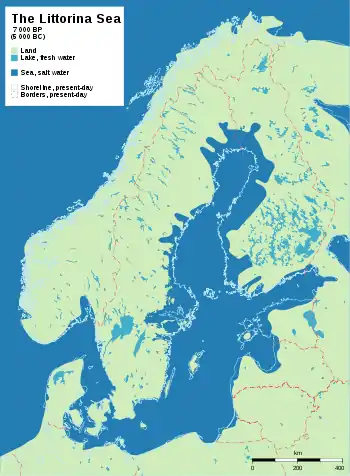Littorina Sea
Littorina Sea (also Litorina Sea) is a geological brackish water stage of the Baltic Sea, which existed around 7500–4000 BP and followed the Mastogloia Sea, transitional stage of the Ancylus Lake.

| Evolution of the Baltic Sea |
|---|
| Pleistocene |
|
Eemian Sea (130,000–115,000 BP) Ice sheets and seas (115,000–12,600 BP) |
| Holocene |
|
Baltic Ice Lake (12,600–10,300 BP) Yoldia Sea (10,300–9,500 BP) Ancylus Lake (9,500–8,000 BP) Mastogloia Sea (8,000–7,500 BP) Littorina Sea (7,500–4,000 BP) Modern Baltic Sea (4,000 BP–present) |
This stage and form of the body of water is named after common periwinkle (Littorina littorea), then a prevailing mollusc in the waters, which indicates its salinity.
Greater size of the ocean-linked sea is termed a transgression, thus widening its ocean link and reaching a peak of salinity, namely during the warmer Atlantic period of European climatology. At this peak, approximately 4500 BP, the sea bore twice the volume of water and covered 26.5% more land than it does today. As the period ended, modern coast features appeared widely, including the lagoons, spits and dunes at most places. Notable exceptions are steep terraces such as the Øresund where the recession of sea level exposes less dry land.
During the period the temperate deciduous forest crept north to cover the littoral hinterland.
Bibliography
- Wefer, Gerold (2002). Climate Development and History of the North Atlantic Realm. Springer. pp. 217–219. ISBN 3-540-43201-9.